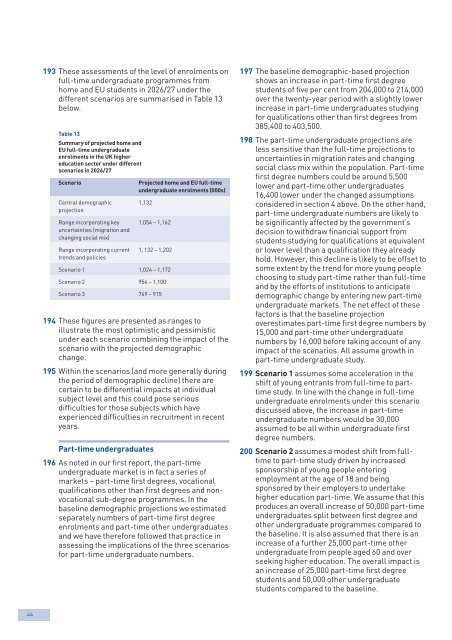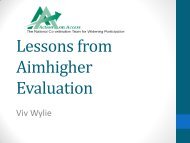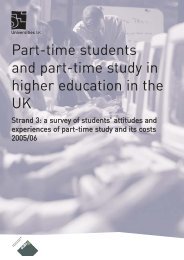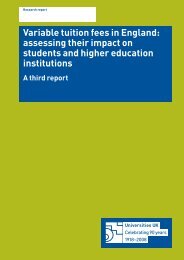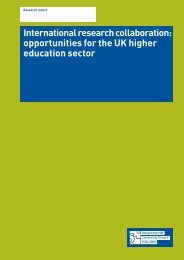The future size and shape of HE - Universities UK
The future size and shape of HE - Universities UK
The future size and shape of HE - Universities UK
- No tags were found...
Create successful ePaper yourself
Turn your PDF publications into a flip-book with our unique Google optimized e-Paper software.
193 <strong>The</strong>se assessments <strong>of</strong> the level <strong>of</strong> enrolments onfull-time undergraduate programmes fromhome <strong>and</strong> EU students in 2026/27 under thedifferent scenarios are summarised in Table 13below.Table 13Summary <strong>of</strong> projected home <strong>and</strong>EU full-time undergraduateenrolments in the <strong>UK</strong> highereducation sector under differentscenarios in 2026/27ScenarioCentral demographic 1,132projectionRange incorporating key 1,054 – 1,162uncertainties (migration <strong>and</strong>changing social mix)Range incorporating current 1, 132 – 1,202trends <strong>and</strong> policiesScenario 1 1,024 – 1,172Scenario 2 954 – 1,100Scenario 3 769 – 915Projected home <strong>and</strong> EU full-timeundergraduate enrolments (000s)194 <strong>The</strong>se figures are presented as ranges toillustrate the most optimistic <strong>and</strong> pessimisticunder each scenario combining the impact <strong>of</strong> thescenario with the projected demographicchange.195 Within the scenarios (<strong>and</strong> more generally duringthe period <strong>of</strong> demographic decline) there arecertain to be differential impacts at individualsubject level <strong>and</strong> this could pose seriousdifficulties for those subjects which haveexperienced difficulties in recruitment in recentyears.Part-time undergraduates196 As noted in our first report, the part-timeundergraduate market is in fact a series <strong>of</strong>markets – part-time first degrees, vocationalqualifications other than first degrees <strong>and</strong> nonvocationalsub-degree programmes. In thebaseline demographic projections we estimatedseparately numbers <strong>of</strong> part-time first degreeenrolments <strong>and</strong> part-time other undergraduates<strong>and</strong> we have therefore followed that practice inassessing the implications <strong>of</strong> the three scenariosfor part-time undergraduate numbers.197 <strong>The</strong> baseline demographic-based projectionshows an increase in part-time first degreestudents <strong>of</strong> five per cent from 204,000 to 214,000over the twenty-year period with a slightly lowerincrease in part-time undergraduates studyingfor qualifications other than first degrees from385,400 to 403,500.198 <strong>The</strong> part-time undergraduate projections areless sensitive than the full-time projections touncertainties in migration rates <strong>and</strong> changingsocial class mix within the population. Part-timefirst degree numbers could be around 5,500lower <strong>and</strong> part-time other undergraduates16,400 lower under the changed assumptionsconsidered in section 4 above. On the other h<strong>and</strong>,part-time undergraduate numbers are likely tobe significantly affected by the government’sdecision to withdraw financial support fromstudents studying for qualifications at equivalentor lower level than a qualification they alreadyhold. However, this decline is likely to be <strong>of</strong>fset tosome extent by the trend for more young peoplechoosing to study part-time rather than full-time<strong>and</strong> by the efforts <strong>of</strong> institutions to anticipatedemographic change by entering new part-timeundergraduate markets. <strong>The</strong> net effect <strong>of</strong> thesefactors is that the baseline projectionoverestimates part-time first degree numbers by15,000 <strong>and</strong> part-time other undergraduatenumbers by 16,000 before taking account <strong>of</strong> anyimpact <strong>of</strong> the scenarios. All assume growth inpart-time undergraduate study.199 Scenario 1 assumes some acceleration in theshift <strong>of</strong> young entrants from full-time to parttimestudy. In line with the change in full-timeundergraduate enrolments under this scenariodiscussed above, the increase in part-timeundergraduate numbers would be 30,000assumed to be all within undergraduate firstdegree numbers.200 Scenario 2 assumes a modest shift from fulltimeto part-time study driven by increasedsponsorship <strong>of</strong> young people enteringemployment at the age <strong>of</strong> 18 <strong>and</strong> beingsponsored by their employers to undertakehigher education part-time. We assume that thisproduces an overall increase <strong>of</strong> 50,000 part-timeundergraduates split between first degree <strong>and</strong>other undergraduate programmes compared tothe baseline. It is also assumed that there is anincrease <strong>of</strong> a further 25,000 part-time otherundergraduate from people aged 60 <strong>and</strong> overseeking higher education. <strong>The</strong> overall impact isan increase <strong>of</strong> 25,000 part-time first degreestudents <strong>and</strong> 50,000 other undergraduatestudents compared to the baseline.44


